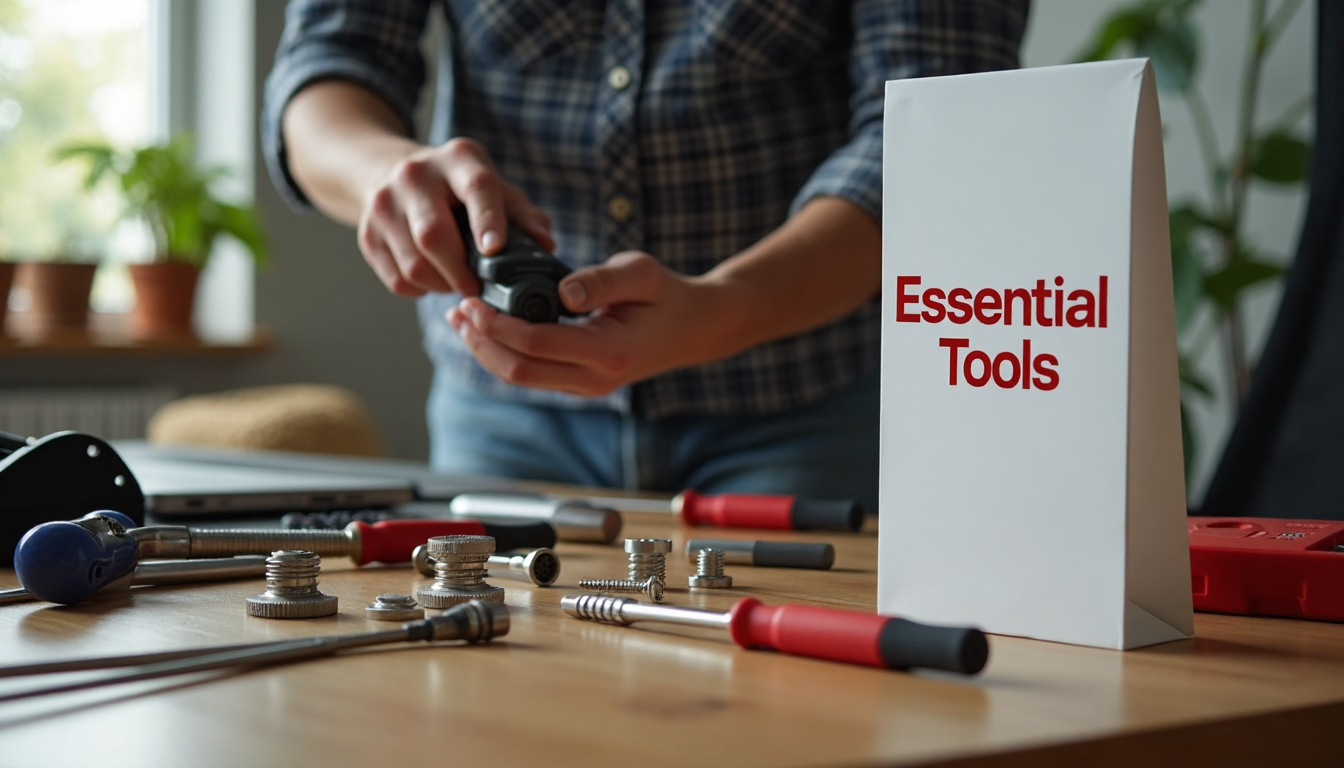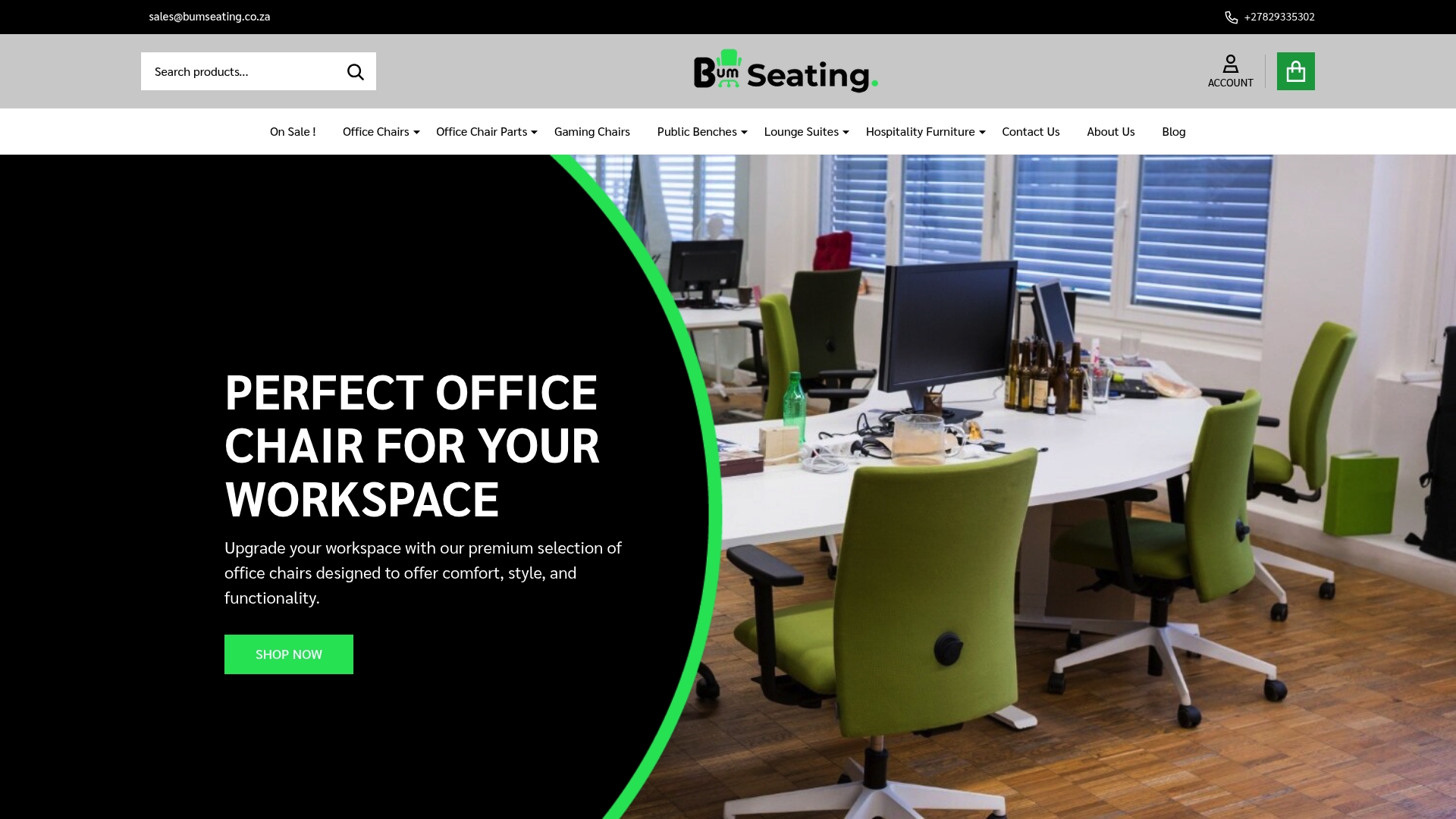Office Chair Repair Basics 2025: Easy Solutions for South Africa
10th Jul 2025
Office Chair Repair Basics 2025: Easy Solutions for South Africa

South Africans spend around 68.63 percent of their workday in chairs with faulty adjustments or rigid backrests, according to recent occupational health research. Surprised? Most people blame their sore backs on long hours, but it turns out the real culprit might be the chair itself. With a few simple repairs, your old office chair could offer better comfort and support than you thought possible.
Table of Contents
- Identifying Common Office Chair Problems
- Essential Tools And Materials For Repairs
- Step-By-Step Guide To Basic Fixes
- When To Replace Versus Repair Your Chair
Quick Summary
| Takeaway | Explanation |
|---|---|
| Identifying Common Chair Issues | Recognize structural damage, ergonomic misalignment, and material degradation to maintain office chair functionality and comfort. |
| Essential Repair Tools | Equip yourself with basic mechanical tools, upholstery materials, and specialized restoration tools for effective chair repair. |
| Step-by-Step Repair Guide | Follow structured procedures for resolving common issues like height adjustments, upholstery restoration, and structural reinforcement to extend chair lifespan. |
| When to Repair vs. Replace | Evaluate repair costs against new chair pricing and assess structural integrity and ergonomic functionality to make informed decisions about chair replacement. |
Identifying Common Office Chair Problems
Office chairs are critical to workplace comfort and productivity, yet many South African professionals struggle with chairs that compromise their health and work performance. At Bum Seating, we understand the complexities of seating solutions and the significant impact a well-maintained chair can have on daily work experience.
Structural Wear and Mechanical Failures
Physical damage represents the most immediate category of office chair problems. The ergonomic integrity of your seating can deteriorate through multiple mechanisms. According to the Journal of Occupational Health, 68.63% of participants reported chairs with unadjustable features and fixed backrests, which significantly contribute to musculoskeletal discomfort.
Typical structural issues include:
- Broken Wheels: Wheels that no longer roll smoothly or have fallen off
- Cracked Plastic Components: Seat bases or armrest supports showing visible fractures
- Loose Mechanism: Chair height adjustment or tilt function becoming unreliable
Ergonomic Misalignment and Comfort Degradation
Beyond physical damage, ergonomic misalignment presents subtle yet profound challenges. The Canadian Centre for Occupational Health and Safety emphasizes that chairs lacking proper lumbar support can cause chronic lower back pain by failing to maintain the spine’s natural curve.
Key ergonomic problems manifest through:
- Inadequate Lumbar Support: Lower back experiencing consistent strain
- Incorrect Seat Height: Improper leg positioning leading to reduced circulation
- Insufficient Padding: Seat cushions that have compressed or lost resilience
Material Degradation and Performance Decline
Material wear represents a nuanced but critical aspect of chair deterioration. Fabrics, leather, and synthetic coverings experience gradual breakdown, impacting both aesthetic appeal and functional performance. The University of North Carolina’s Environment, Health and Safety department highlights how improper chair configurations can exponentially accelerate material degradation.
Common material-related issues include:
- Fabric Tears: Small rips expanding into significant damage
- Leather Cracking: Surface breakdown particularly in high-friction areas
- Foam Compression: Seat cushions losing their original supportive structure
Recognizing these problems early enables proactive maintenance and potential repair, ultimately extending your office chair’s functional lifespan. At Bum Seating, we recommend regular inspections and addressing issues promptly to maintain optimal workplace comfort.
![]()
Ready to transform your seating experience? Explore our comprehensive chair repair solutions and ensure your workspace remains comfortable and productive.
Essential Tools and Materials for Repairs

Effective office chair repair demands a strategic approach and a well-curated toolkit. At Bum Seating, we understand that having the right tools can transform a potential replacement scenario into a successful repair, saving both money and workplace productivity.
Basic Mechanical Repair Tools
Every professional and DIY enthusiast requires a foundational set of tools for addressing mechanical chair issues. According to international furniture maintenance experts, the core toolkit should include:
- Screwdriver Set: Including Phillips and flathead varieties for different fastener types
- Allen Wrenches (Hex Keys): Critical for adjusting and replacing mechanism components
- Adjustable Pliers: Useful for gripping and manipulating small mechanical parts
- Rubber Mallet: Helps realign components without causing additional damage
These tools enable precise interventions in chair mechanisms, allowing for targeted repairs that restore functionality without requiring complete replacement. Proper tool selection prevents unnecessary force that might compromise the chair’s structural integrity.
Upholstery and Surface Repair Materials
South African upholstery specialists recommend a comprehensive set of materials for addressing fabric and surface damage. Essential items include:
- Fabric Scissors: Precision cutting for patch repairs
- Staple Gun: Reattaching loose fabric and securing new upholstery
- Foam Cutters: Replacing worn seat and backrest cushioning
- Heavy-Duty Needles: Repairing fabric tears and seam separations
- Fabric Adhesives: Bonding materials without visible stitching
Understanding material compatibility is crucial. Different office chair fabrics—leather, mesh, synthetic blends—require specific repair approaches and matching materials.
Specialized Restoration Tools
Furniture restoration professionals emphasize the importance of specialized tools for comprehensive chair rehabilitation:
- Wood Chisels: Repairing wooden frame components
- Wood Files: Smoothing and refining wooden surfaces
- Putty Knives: Filling small cracks and surface imperfections
- Clamps: Holding components during repair and allowing adhesives to set
- Precision Measuring Tape: Ensuring accurate replacement part fitting
These specialized tools enable nuanced repairs that go beyond simple mechanical fixes, addressing structural and aesthetic challenges in office chairs.
At Bum Seating, we recommend investing in quality tools and maintaining a well-organized repair kit. Proper maintenance not only extends chair life but also demonstrates a commitment to workplace efficiency and employee comfort.
Want professional guidance on chair repairs? Explore our comprehensive repair solutions and transform your workspace maintenance strategy.
To help you choose the right approach for different chair issues, here is a summary table comparing the three major categories of common chair problems and their typical examples from the sections above:
| Problem Type | Typical Issues | Impact on Comfort/Function |
|---|---|---|
| Structural Wear & Mechanical Failures | Broken wheels, cracked plastic, loose mechanism | Limits adjustment, causes instability |
| Ergonomic Misalignment & Comfort Issues | Inadequate lumbar support, seat height, insufficient padding | Back pain, poor posture, reduced circulation |
| Material Degradation & Performance Decline | Fabric tears, leather cracking, foam compression | Appearance decline, less support, discomfort |
Step-by-Step Guide to Basic Fixes
Maintaining office chairs requires practical knowledge and a systematic approach. At Bum Seating, we understand that many repair tasks can be accomplished with patience, the right tools, and clear guidance. This step-by-step guide will empower South African professionals to tackle common chair issues confidently.
Resolving Chair Height and Mechanism Problems
Family Handyman experts recommend a structured approach to addressing gas cylinder and mechanism issues. When your chair fails to maintain height or experiences inconsistent movement, follow these precise steps:
-
Diagnose the Problem
- Check if the chair sinks immediately after sitting
- Verify the gas cylinder’s responsiveness to height adjustment
- Inspect the base and mechanism for visible damage
-
Gas Cylinder Replacement
- Remove the chair base by turning the chair upside down
- Use a pipe wrench to detach the old gas cylinder
- Insert the new cylinder, ensuring proper alignment
- Reattach the base and test the chair’s stability
-
Mechanism Adjustment
- Locate the tilt tension adjustment mechanism
- Use an Allen wrench to tighten or loosen the tension
- Test the chair’s responsiveness and comfort
Upholstery and Surface Restoration
The Guardian’s furniture restoration guide provides insights into breathing new life into worn office chairs. Reupholstering can transform a tired chair into a comfortable workspace essential:
-
Fabric Removal
- Carefully remove existing fabric
- Use the old fabric as a precise cutting template
- Inspect padding for damage or compression
-
Preparation and Cutting
- Choose durable, office-appropriate fabric
- Cut new fabric with additional margin for secure attachment
- Ensure pattern alignment and symmetry
-
Reupholstering Process
- Use a staple gun for secure fabric attachment
- Pull fabric taut to prevent wrinkles
- Trim excess material for a clean finish
Structural Repairs and Reinforcement
Cambridge University’s furniture maintenance research highlights the importance of structural integrity. When addressing chair back or frame issues, follow these critical steps:
-
Structural Assessment
- Inspect chair back for cracks or weakness
- Identify load-bearing points of stress
- Determine whether repair or replacement is necessary
-
Reinforcement Techniques
- Use metal support bars for additional stability
- Apply wood glue to reinforce wooden components
- Use clamps to hold repairs while adhesives set
-
Final Verification
- Test the chair’s weight-bearing capacity
- Check for smooth movement and stability
- Ensure all repairs are secure and functional
Below is a step-by-step process table summarising the three major categories of office chair fixes and their main procedures:
| Repair Category | Key Steps |
|---|---|
| Height/Mechanism Problems | Diagnose → Replace gas cylinder → Adjust mechanism tension |
| Upholstery & Surface Restoration | Remove fabric → Cut/prepare new fabric → Attach & finish |
| Structural Repairs & Reinforcement | Assess damage → Reinforce joints/structure → Verify stability |
By following these systematic approaches, you can extend your office chair’s lifespan and maintain workplace comfort. Remember that some complex repairs might require professional intervention.
Need expert advice on chair repairs? Explore our professional repair solutions and keep your workspace comfortable and productive.
When to Replace Versus Repair Your Chair
Deciding between repairing and replacing an office chair represents a critical decision for South African businesses and professionals. At Bum Seating, we understand that this choice impacts workplace productivity, employee comfort, and long-term financial planning.
Economic Considerations of Chair Repair
Furniture maintenance experts recommend a strategic approach to evaluating chair repair economics. The fundamental rule is straightforward: if repair costs exceed 50% of a new chair’s price, replacement becomes the more prudent option.
Key economic factors to consider include:
- Repair Cost Percentage: Calculate total repair expenses compared to new chair pricing
- Long-term Durability: Assess whether repairs will extend the chair’s functional lifespan
- Performance Restoration: Determine if repairs can fully restore the chair’s original ergonomic capabilities
Structural and Ergonomic Assessment
Workplace ergonomics specialists emphasize comprehensive evaluation beyond simple cost calculations. Critical indicators suggesting replacement include:
- Irreparable Frame Damage: Structural cracks or breaks compromising chair stability
- Persistent Ergonomic Failures: Mechanisms that cannot maintain proper support and adjustment
- Advanced Material Degradation: Extensive fabric wear or foam compression beyond effective restoration
Professional Evaluation Criteria
Occupational health researchers recommend a systematic approach to chair assessment:
-
Age Analysis
- Evaluate the chair’s current age and original manufacturing quality
- Consider standard industry lifespan expectations (typically 5-7 years)
- Review maintenance history and previous repair interventions
-
Functional Performance
- Test height adjustment mechanisms
- Verify tilt and swivel functionality
- Assess overall structural integrity and load-bearing capacity
-
Comfort and Ergonomic Compliance
- Check lumbar support effectiveness
- Evaluate seat cushioning and pressure distribution
- Ensure alignment with contemporary ergonomic standards
At Bum Seating, we recommend periodic professional assessments to make informed decisions about chair maintenance. While repairs can extend a chair’s life, timely replacement ensures optimal workplace comfort and productivity.
Remember that investing in quality seating is fundamentally an investment in employee health, performance, and organizational efficiency. Small compromises in chair quality can lead to significant productivity and wellness challenges.
Ready to upgrade your office seating? Explore our professional chair solutions and transform your workplace comfort today.
Frequently Asked Questions
What are common problems with office chairs?
Common office chair problems include structural wear (like broken wheels and loose mechanisms), ergonomic misalignment (such as inadequate lumbar support and incorrect seat height), and material degradation (including fabric tears and foam compression).
How can I repair my office chair at home?
You can repair your office chair at home by diagnosing issues (like gas cylinder problems), replacing damaged parts, reupholstering worn fabric, and reinforcing structural components. Basic tools like screwdrivers and staple guns are essential for these repairs.
When should I replace my office chair instead of repairing it?
You should consider replacing your office chair if repair costs exceed 50% of the price of a new chair, or if the chair has irreparable frame damage, persistent ergonomic failures, or advanced material degradation.
What tools do I need for office chair repairs?
Essential tools for office chair repairs include a screwdriver set, Allen wrenches, adjustable pliers, rubber mallet, fabric scissors, staple gun, and upholstery materials like fabric adhesive and heavy-duty needles.
Upgrade Comfort and Productivity with Bum Seating Today
Have you noticed that your workspace chair struggles with broken wheels, sinking seats, or worn-out fabric just like described in our repair guide? Prolonged use of an uncomfortable or malfunctioning chair not only causes daily frustration but can also lead to lower back pain and reduced productivity. Trying to fix recurring ergonomic and structural problems on your own can feel like a never-ending battle, especially when old mechanisms just refuse to cooperate.

Stop settling for a chair that holds you back when a long-lasting solution is just a click away. Experience the difference that expertly designed seating can make for your health and your workday. Visit Bum Seating now to explore our wide range of modern ergonomic office chairs and seating accessories. Make the smart move and invest in lasting comfort and support for your workspace. The sooner you upgrade, the more comfortable tomorrow will feel.
Recommended
- Designing Comfortable Workspaces with Our Chair Selection - Bum Seating
- Design Tips for Selecting Ergonomic Office Chairs - Bum Seating
- Making a Lasting Impression: The Importance of Reception Sofas in Your Office - Bum Seating
- Creating a Winning Workspace: How Seating Affects Employee Performance - Bum Seating
- Tips for Choosing the Right Hospitality Furniture for Your Venue - Bum Seating
- Upgrading Your Office Furniture: Smart Choices for 2025 - Bum Seating
